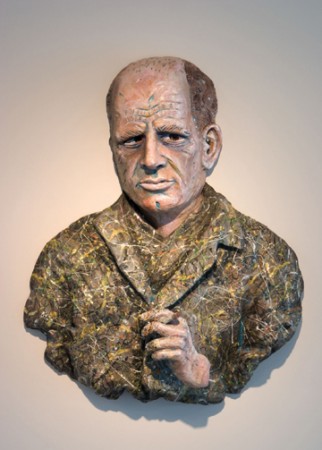In our continuing effort to bring CAU readers news about events taking place in the Carolina pottery community, I’m scooping Carolina Arts in bringing you this article about an exhibit now on view at the Columbia Museum of Art in Columbia.
The Columbia Museum of Art in Columbia, SC, will present the exhibit,Innovation and Change: Great Ceramics from the Ceramics Research Center, on view from May 28 through Sept. 5, 2010.
The exhibition highlights 79 masterworks by many of the leading international ceramic artists of our day, offering a panoramic survey of the potential of clay as an expressive art form. The Ceramics Research Center in Arizona contains one of the most exceptional collections of contemporary ceramics in the United States.
The art objects on view range from functional ware for everyday use to more expressive sculptural forms. The exhibition includes featured works by 70 prominent artists including: Rudy Autio (American, 1926-2007), whose highly sculptural works decorated with brightly colored figures earned him the nickname, “the Matisse of ceramics”; Peter Voulkos (American, 1924-2002), one of the early founders of the American ceramic movement, whose ceramic sculptures are famous for their visual weight, their freely formed construction, and their aggressive and energetic decoration; Robert Arneson (American, 1930-1992) – “father of the ceramic Funk Movement” – who in the early 1960s abandoned the traditional manufacture of functional ceramic objects in favor of using everyday objects to make confrontational statements; and Betty Woodman (American, born 1930), who integrates color and form into complex sculpture based on the historical traditions of pottery making, most notably that of ancient China and Italian majolica. One of the most influential ceramic artists of the 20th century, Woodman was recognized for her outstanding contributions to the field and honored as the first living woman artist to have a solo exhibition at the Metropolitan Museum of Art in 2006.

“The Abstract Expressionist”, 1985
Robert Arneson (1930-1992)
Karen Brosius, the Museum’s executive director says, “The museum is delighted to present this comprehensive exhibition of talented artists that provides the community and our visitors a satisfying discovery and enjoyment of the world of ceramics.”
Some of the artists started their careers when the studio movement in America was in its infancy. After World War II, there was renewed interest in the craft movement, with many universities establishing programs and more museums presenting their work. Influenced by European modernist design, as well as Asian pottery traditions, emerging ceramic pioneers created a new American aesthetic.
During the 1960s, the craft field matured and prospered. Bernard Leach and Shoji Hamada were influential figures in the field, promulgating the value of functional pottery in everyday life. But an American revolution in clay began under the charismatic leadership of Peter Voulkos, who embraced and redefined the potential of clay as an innovative form of contemporary art, which embraced individual expression rather than following the crowd. Rules were broken and a new ceramic frontier was born.
The figure became a prominent foil for artistic expression in clay and witnessed a resurgence of interest in the 1960s, primarily from West Coast artists, including Robert Arneson and Viola Frey. During the 1970s and 1980s, another sea change took place. Many artists began using the vessel format to express painterly concerns or to convey personal stories, either as painted narration on the surface or as fully integrated form and design. With each successive generation, emerging artists have forged a new voice within the ceramic idiom. Borrowing freely from different time epochs and cultures, as well as being more fluid between art mediums, they are not limited by past traditions.
The showing in Columbia is part of a 10-city national tour over a three year period containing 79 ceramic vessels and sculptures from the collection of the Ceramics Research Center, Arizona State University Art Museum. The exhibition was curated by Peter Held, Curator of Ceramics and was developed and managed by Smith Kramer Fine Art Services, an exhibition tour development company in Kansas City, Missouri.
Innovation and Change: Great Ceramics from the Ceramics Research Center has been organized by the Arizona State University Art Museum located near Phoenix in Tempe, AZ.
From June 16 throu September 19, 2010, the Museum will also present,SC6: Six South Carolina Innovators in Clay.
Drawn from public and private collections, six innovative ceramic artists who are, or have been active in South Carolina are featured in this Gallery 15 installation. The works illustrate a diverse range of technique, glazes and forms for which the artists are best known. Featured artists include: Russell Biles, from Greenville, whose figural sculptures are deeply laden with social and political commentary; Jim Connell, whose sinuous vessels are decorated with elaborate glazes, many of which are inspired by ancient Chinese ceramics; Georgia Henrietta Harris, a member of the Catawba Nation, who is largely credited with reviving the Catawba pottery tradition; Peter Lenzo, whose technically complex sculptures recall the 19th century Southern “face jug” tradition yet remain completely unique; Ron Meyers, whose functional ceramics are brightly slip-painted in a gestural, expressionistic style that can be both provocative and confrontational; and Virginia Scotchie, current chair of the ceramics department at USC, who incorporates familiar shapes when creating her vessels that possess complex and luminous glazes.
For further information check our SC Institutional Gallery listings, call the Museum at 803/799-2810 or visit (www.columbiamuseum.org).
